3 Reasons Why I Always Apply a Tea Stain to my DIY Furniture
Why in the world would I ever apply tea to my DIY furniture? Yes, tea! You know, the kind of tea you drink, like Earl Grey? What benefit could applying tea possibly have for DIY furniture? I always apply a tea stain before I apply wood stain to my DIY furniture and today I’m sharing three reasons why you should too.
For your convenience, this post contains affiliate links to supplies or tools I used to complete this project. Purchases made using these links help support the Saws on Skates website and allow me to share more DIY projects. and DIY tips with you. There is no cost to you for using these links. Click here to visit my site policies.
What is a Tea Stain?
A tea stain is essentially a strongly brewed batch of tea. After the tea is brewed it’s applied to my DIY furniture with a foam paint brush. I should point out anytime a water-based product is applied to wood, like a tea stain, it raises the grain of the wood. This means the surface is no longer smooth. Once the tea stain is dry, the surface of the wood should be lightly sanded with 220 grit sandpaper.
You may also enjoy: How to Stain Wood With Coffee and How to Make a DIY Black Walnut Stain
That’s a tea stain in a nutshell, but why do we want to apply it to our DIY furniture? There are three benefits of applying a tea stain to our projects. It prevents blotchiness, evens out the wood tone and wood treated with a tea stain will actually stain darker than wood that hasn’t been treated with tea.
Prevents Blotchiness
If you have ever stained a piece of pine furniture you know it often gets a patchy, blotchy look. You just spent a ton of time and money building a beautiful piece of DIY furniture and now it looks like a Rorschach inkblot test – arrrrgggghhhh!!! I don’t know about you, but that’s definitely not the professional look I want for my DIY furniture. But you can prevent that blotchiness by applying a tea stain.
Evens Out Wood Tone
Not only does the tea stain prevent the wood from becoming blotchy, another benefit is it evens out the wood tone. If you have ever stained a piece of pine furniture you know some parts of the wood stain really dark and other parts hardly absorbs the stain at all. Wood treated with a tea stain absorbs wood stains more evenly and uniformly. This produces a more professional look for our furniture.
Dark, Rich Stain
Hey, wait a minute… isn’t there a product you can buy that prevents blotchiness and makes the wood absorb the stain more evenly? Yes, you can buy a wood conditioner that achieves a similar result to a tea stain, but for me, I prefer a tea stain. Both the wood conditioner and tea stain prevent blotchiness and evens out the wood tone, but the real difference comes in the way they accept stain.
Related: What I Use Instead of Wood Conditioner
It appears to me store bought wood conditioner prevents blotchiness by preventing the wood stain from soaking too deeply into the wood. In my experience furniture pieces treated with a wood conditioner produces a lighter stain color than I anticipated. Wood treated with a tea stain practically sucks the stain into the fibers of the wood and produces a darker, richer color which is exactly the look I want.
Tea Stain Revealed
OK, so I told you about all of the benefits of a tea stain, now you want to see it in action, right? Take a look at the book-matched panels I made for the DIY bathroom vanity. The entire vanity, including the panels, were first tea stained and then stained with a coat of my favorite wood stain, Rust-Oleum Dark Walnut wood stain. The piece I’m holding was just stained with a coat of Rust-Oleum Dark Walnut wood stain. It’s a dramatic difference, right?!
The bathroom vanity panels are not blotchy and have a dark, rich uniform color while the test piece is really dark in spots and really light in other spots. Man, I’m sooo glad I did a test piece on a leftover piece of the panel before I stained the whole vanity and I’m sooo glad I applied a tea stain. The color of the vanity turned out exactly how I envisioned it.
Why Tea Stain Works
Now we know what a tea stain does and all of the amazing benefits, but why does it work? Wood contains tannic acid. Tannic acid contributes to the color of wood. Typically lighter woods have less tannic acid and darker woods have more tannic acid. For instance, I build most of my DIY furniture projects with white pine. White pine is, well, it’s pretty white and would contain less tannic acid than a wood like red oak.
When you apply a tea stain, the tea reacts with the tannic acid in the wood. The tea stain itself doesn’t really change the color of the wood very much, but when a wood stain is applied, the color change is dramatic.
How to Make a Tea Stain
Boil about 1-1/2 cups of water and add 10 Bigelow English Teatime Black Tea bags. I usually make my tea stain in a mason jar, so I can seal it and store in the refrigerator if I need to. Steep the tea bags for 30 minutes to an hour and then remove the tea bags.
How to Apply a Tea Stain
Once you have your tea brewed, the application is easy. Take a foam paint brush, dip it in your tea and apply it to your furniture project. That’s it! Well, there is one more thing we need to do.
Anytime a water-based product is applied to wood, like a tea stain, it raises the grain of the wood, so the surface is no longer smooth. Once the tea stain is dry, the surface of the wood needs to be lightly sanded with 220 grit sandpaper. And when I say lightly, I mean sand very lightly. We only want to knock off the wood fibers that raised up. Just a few, light passes should do it.
Apply Wood Stain
Now that you’ve applied the tea stain and sanded the raised wood fibers, you’re ready to apply your wood stain. I’m a BIG fan of Rust-Oleum Ultimate Wood Stains. I love the one coat coverage, the quick drying time and Rust-Oleum stains always produce dark, rich stain colors.
Just a note about working wood stain when using a tea stain. Wood treated with a tea stain absorbs wood stain much more quickly than untreated wood. Because of this, you won’t need to leave the stain on as long as recommended by the instructions for your wood stain. You’ll want to start removing it just before it looks like it’s starting to dry. If you leave it on too long, the wood stain will dry and will be difficult to remove.
Take it a Step Further
Want your furniture project even darker? You can apply a tea stain and then oxidize the wood with a solution of vinegar and steel wool. Check out my Dark Chocolate stain post for details.
Conclusion
I recommend before you use a tea stain on your project that you try it out on a test piece and be sure it produces the color you were hoping for. I think you’ll be impressed with the results! A tea stain prevents blotchiness, evens the wood tone and tea stained wood stains darker than wood that hasn’t been treated with a tea stain.
Have you ever used a tea stain? What did you think of the results? Share your thoughts in the comments. Oh, and if you found this information helpful, would you please pin it to Pinterest?
PIN THIS!

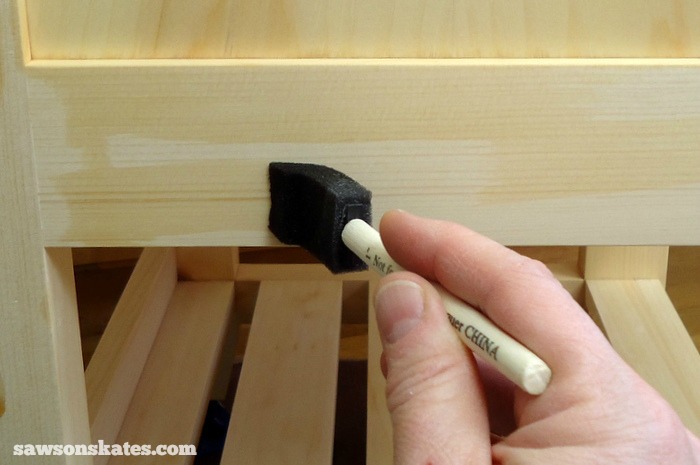
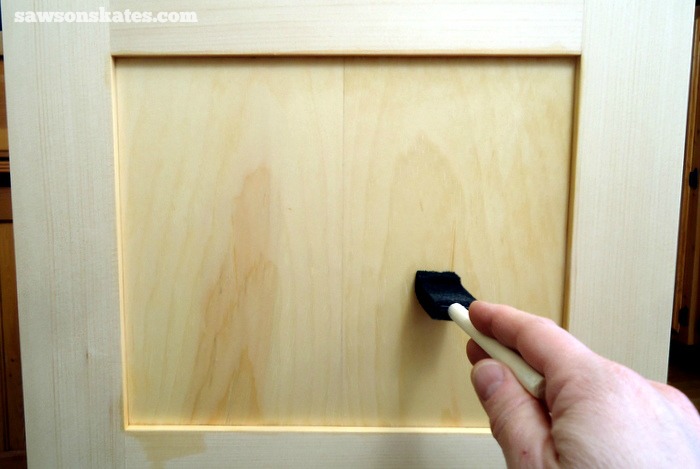
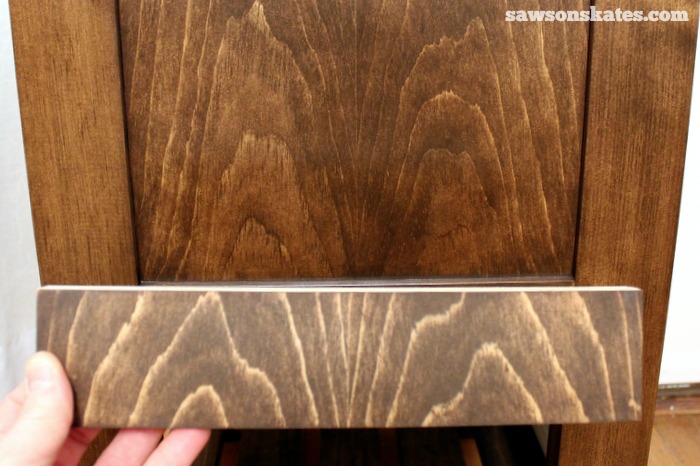
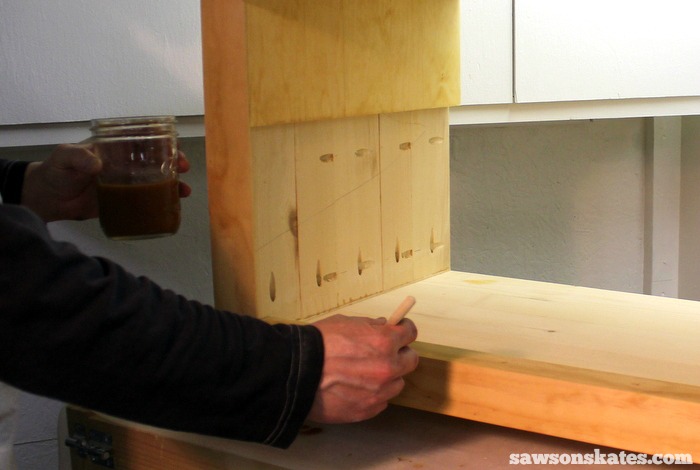
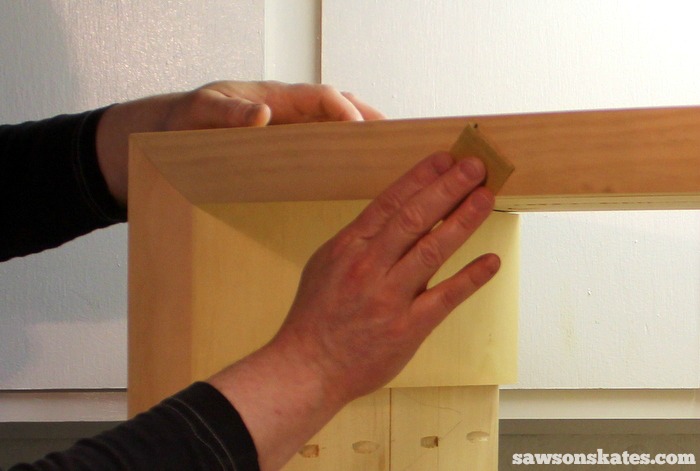
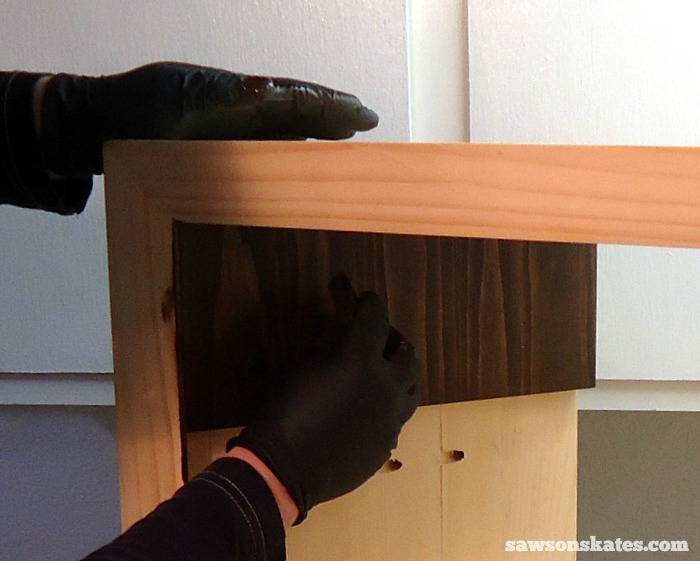
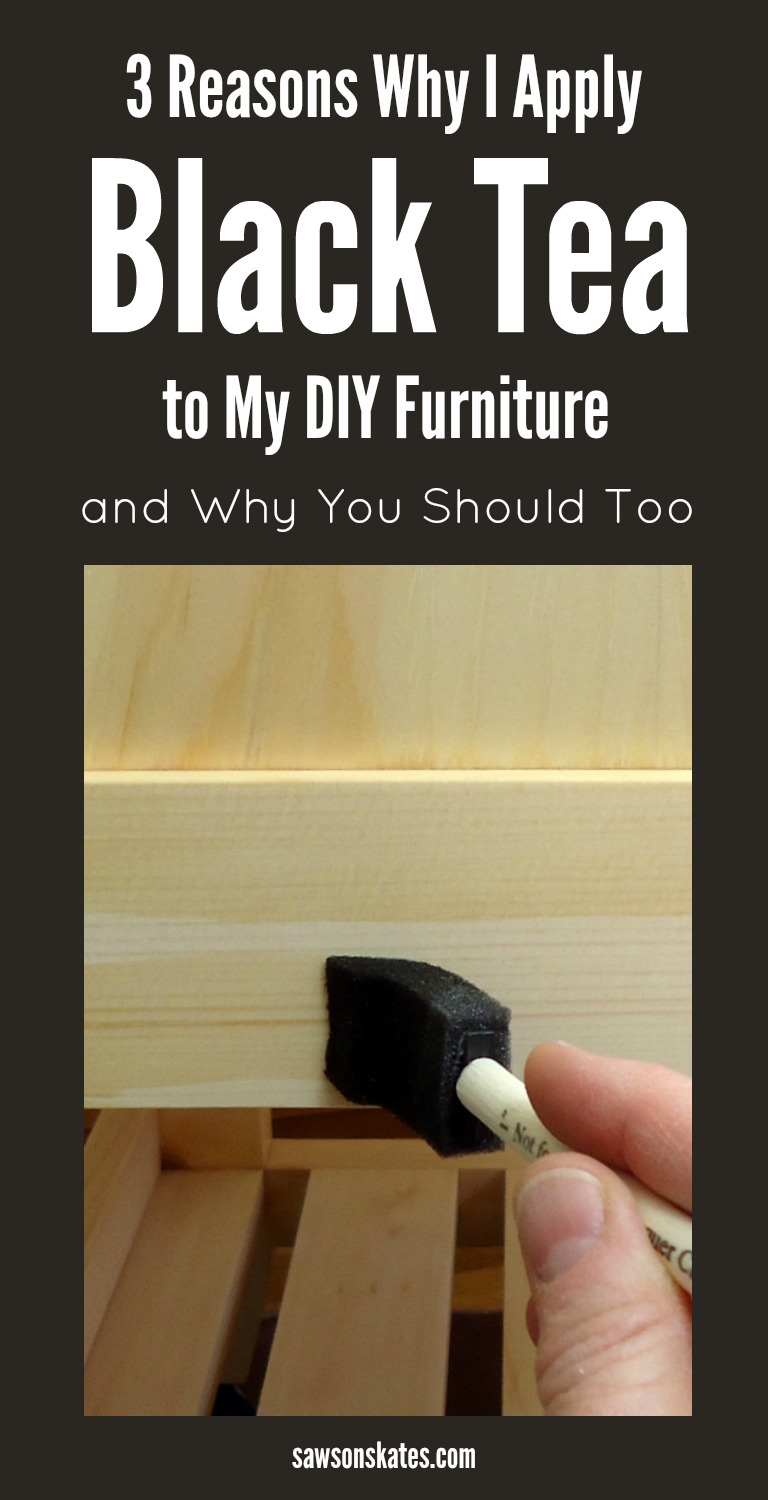
Will other brands of tea work? Can it be any brand of black tea? I dont know how far a dollar a bag will get me.
Hi Justin – Thank you for stopping by. Yes, other brands and other types of tea will work. It’s possible the color of the tea may slightly tint the wood. In other words, a green tea may add a slightly greenish tint to the wood. It’s always a good idea to try whatever tea you go with on some test pieces before using on your finished project.
I have not used tea but I have used coffee grounds boiled to darken outdoor treated pine. Worked well
Thanks for tea info. I will try it
Hi Richard – Thank you for stopping by. I haven’t tried coffee to darken wood, so you taught me something. I’m going to give this a try!
Would you still recommend tea stain when trying to use the minwax white stain?
Hi Alicia – Thank you for stopping by. I’ve never worked with white stain. You may want to try it on some test pieces first before using it on your finished project to see if it gives you the look you want.
Hi Scott. I love the tea pre-stain method. I have used it a number of times I generally use minwax English chestnut oil based stain and I get a nice rich dark result. My question is that I just finished a couple of lazy Susan’s and I want to use a golden oak oil based stain. I am thinking of diluting the tea stain so I do not gets too deep or too dark result from the full strength tea stain. Your thoughts?
Hi Jack – Thank you for stopping by. I always like to run some tests when I’m trying something different, so my suggestion would be to try this on a couple of test pieces first. Test one at full strength and one diluted and see which one you like the best.
How long does the tea stain last once it is made.
Hi William – Thank you for stopping by. This is a “food-based” product, so I’m not sure for certain how long it will last. In other words, based on temperatures, etc. it could start to get moldy. You could refrigerate the tea to help it last longer or make smaller batches as needed for your projects.
How does the Tea compare to Minwax Pre-Stain wood conditioner? Can they both be used? Or will that have negative impact on the finish? Not sure… Thanks!
Hi Mike – Thank you for stopping by. In my opinion, applying a tea stain prior to applying a wood stain gives the piece a deeper, richer color compared to a wood conditioner.
I have not used a tea stain and wood conditioner together. You might want to try them together on a test piece before trying on your finished project to be sure it will give you the results you’re looking for.
I just tea stained my new pine floorboards to match in with other floorboards that were sanded and clear varnished 4 yrs ago. The older floor had gone a nice golden colour over the years and new section of floor put in due to damp patch didn’t match and I couldn’t find stains to match. I’m now waiting for the floorboards to dry so I can varnish that section in clear varnish. They have come up as a good match. Thanks
Hi Anne – Thank you for stopping by. I’m so glad this technique is working for your floors!
Thank you so much for sharing this idea. I just made my first woodworking project (tiered plant shelf) and I’ve been testing a variety of stains. Everything has looked terrible. I’m using pine and even with prestain some of the fiber stays so light it looks horrible when stained. I tried multiple coats, different oils, and was finally telling myself I’d just have to deal with the natural pine color. Then I found your blog today! I setup a test board with 5 different ratios of stain using the tea method (2 cups water, 13 tea bags, 45 min), and 1 as a control with the standard prestain. Every single color that used the tea as a prestain looked great! My favorite ended up being the one I did two coats of the tea before spreading a Varathane Kona/Cognac mix for 3 minutes. It looks fantastic! Thank you so much for posting this, I can now use cheaper pine lumber rather than hardwoods.
Hi Sarah – Thank you for stopping by. I’m so glad this worked for you! I love this tea trick and use it on all of my stained wood projects!
Hey, Scott! Does it matter what temperature the tea is when you apply it to the wood? I know you said you store what’s left in a mason jar and refrigerate it. Do you heat it up again before use or is it good to go from the refrigerator?
Hi Lori – That’s a great question! I’m not sure if the temperature matters. I usually use it at room temperature or warm it up so that it’s about room temperature. You could try it at room temperature and cold on a few test pieces and see if there is any difference. I would suspect there wouldn’t be, but I would be interested in hearing how the experiment turns out!
Thank you so much for this! I lived in California and used Doug fir with pretty good results. Moved to Georgia and the Yellow pine was killing me, It was so unpredictable piece to piece. Then I had some early wood that wouldn’t take much stain even with the wood conditioner. Spent hours on the internet and money purchasing different types and colors of stains to find something to help… This worked! Me (and my wife whose living room is a construction zone) both thank you greatly!
Hi Kevin – Thank you for stopping by. I’m glad to hear this worked for you!